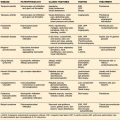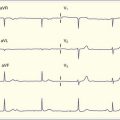194 Psychosis and Psychotropic Medication
• Psychosis refers to symptoms that demonstrate impairment in thought content and process.
• Patients with schizophrenia, bipolar disease, substance abuse, or depression may have psychotic features over time.
• Most psychotic disorders are initially manifested during adolescence and young adulthood.
• Typical antipsychotic medications have high affinity for dopamine receptors and are more effective in treating hallucinations and delusions, the “positive” symptoms of schizophrenia.
• Atypical antipsychotic medications have high affinity for serotonin receptors. These agents are more effective in treating the “negative” behavioral symptoms associated with psychosis.
Definitions and Epidemiology
The 1-year prevalence of the schizophrenic disorders is 1.1%. One in every 100 persons in the United States suffers from psychotic symptoms.1 Episodes of psychosis are generally precipitated or exacerbated by psychosocial stressors. Psychosis may be acute or chronic. As is often the case with the first manifestation of schizophrenia, acute psychotic episodes prompt patients to seek emergency care for their bizarre behavior or troubling perceptions.
Presenting Signs and Symptoms
Most psychotic disorders are initially manifested in adolescence and young adulthood. The median age at the onset of symptoms of a psychiatric disorder is 16 years. By the age of 38 years, symptoms will have developed in more than 90% of patients with a mental disorder.1 The typical example of a newly psychotic patient is a young person brought to the emergency department (ED) by family or friends who are concerned about the patient’s bizarre behavior or unusual beliefs. The “positive” symptoms of psychosis, including hallucinations and delusions, are often more obvious and distressing than the “negative” symptoms, which are affective and generally develop more insidiously.
Diagnostic Testing
A detailed discussion of the emergency psychiatric evaluation can be found in Chapter 193.
Psychotropic Medications
Typical (First-Generation) Antipsychotic Agents
Typical antipsychotic medications have high affinity for D2 receptors, thus blocking dopamine overactivity in the mesocortical pathway. D2 antagonism accounts for the clinical profile of these agents, which are useful in treating the positive symptoms of schizophrenia, namely, hallucinations and delusions.2 Haloperidol (Haldol) is the prototypic agent of this drug class (Table 194.1).
Table 194.1 Typical Antipsychotic Medications (Dopaine2 Receptor Antagonists)
| DRUG | USUAL DOSE | COMMENTS |
|---|---|---|
| Haloperidol (Haldol) |
D2, Dopamine 2; IM, intramuscularly; IV, intravenously; PO, orally.
* Administration of haloperidol intravenously is off label because of the risk for QT prolongation and arrhythmia.
† A “black box” warning was mandated by the Food and Drug Administration in 2001 given the risk for fatal tachyarrhythmias.
Atypical (Second-Generation) Antipsychotic Agents
Atypical antipsychotic medications have higher affinity for serotonin (5-HT2A) receptors than for D2 receptors. Serotonergic neurons in the dorsal raphe nuclei interact with dopaminergic neurons in the nigrostriatal pathway and modulate the clinical effects. Atypical antipsychotic agents are characterized by a lower incidence of EPSs and show a diverse range of binding activities at other receptor sites as well. Serotonin and other neurotransmitter blockade may account for the beneficial effects of atypical antipsychotic agents against negative behavioral symptoms by increasing dopamine activity in the prefrontal cortex (Table 194.2).
Table 194.2 Atypical Antipsychotic Medications (Serotonin and D2 Receptor Antagonists)
| DRUG | USUAL DOSE | COMMENTS |
|---|---|---|
| Clozapine (Clozaril) | 12.5 mg PO bid |
10-15 mg SL (ODT), maximum of 20 mg/day
bid, Twice daily; D2, dopamine 2; IM, intramuscularly; ODT, orally disintegrating tablet; PO, orally; q2h, every 2 hours; SL, sublingually.
Partial Receptor Agonists
Partial receptor agonists demonstrate variable clinical effects, as influenced by the receptor-binding affinity of the agent and the patient’s endogenous levels of neurotransmitter. One available partial agonist, aripiprazole (Abilify), appears to be an effective and possibly a superior treatment option for patients with schizophrenia. It does not completely block the mesolimbic system (associated with “negative” symptoms and cognitive impairment), nor does it completely stimulate the nigrostriatal or tuberoinfundibular pathways responsible for EPSs and elevated prolactin levels.2 Aripiprazole thus has a low side effect profile and is taken orally at a dose of 10 to 30 mg/day.
Benzodiazepines
Benzodiazepines are commonly used to treat psychotic agitation because of their efficacy and tolerability. These agents increase the effects of γ-aminobutyric acid (GABA) on the chloride ionophore of the GABA-benzodiazepine receptor complex, thereby causing sedation and sleepiness. Benzodiazepines are generally administered in combination with typical antipsychotic medications to sedate agitated or violent patients. An added benefit of the administration of benzodiazepines is the treatment of alcohol withdrawal if that is the cause of the agitation.3 Adverse effects, including oversedation and diminished respiratory drive, are minimal at low doses. Rare reports have noted “frontal disinhibition” leading to increased impulsive behavior with benzodiazepine use in patients with previous head injury or mental retardation4 (Table 194.3).
| DRUG | USUAL DOSE | COMMENT |
|---|---|---|
| Lorazepam (Ativan) | 2-4 mg PO or 1-2 mg IM |
IM, Intramuscularly; PO, orally.
Treatment
Any agitation or violent behavior associated with psychosis should be managed as soon as a patient arrives in the ED. Verbal warnings should precede the use of chemical or physical restraint. The least restrictive method of restraint is preferable to facilitate a safe and complete diagnostic evaluation.5,6
1 Norquist GS, Regier DA. The epidemiology of psychiatric disorders and the de facto mental health care system. Annu Rev Med. 1996;47:473–479.
2 Lieberman J. Dopamine partial agonists: a new class of antipsychotic. CNS Drugs. 2004;18:251–267.
3 Rund DA, Ewing JD, Mitzel K, et al. The use of intramuscular benzodiazepines and antipsychotic agents in the treatment of acute agitation or violence in the emergency department. J Emerg Med. 2006;31:317–324.
4 Currier GW, Trenton A. Pharmacological treatment of psychotic agitation. CNS Drugs. 2002;16:219–228.
5 Buckley PF, Noffsinger SG, Smith DA, et al. Treatment of the psychotic patient who is violent. Psychiatr Clin North Am. 2003;26:231–272.
6 Yildiz A, Sachs GS, Turgay A. Pharmacological management of agitation in emergency settings. Emerg Med J. 2003;20:339–346.



